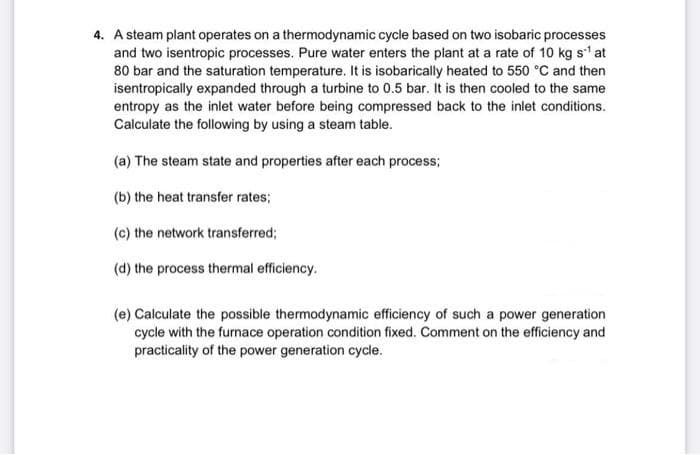A steam plant operates on a thermodynamic cycle based on two isobaric processes and two isentropic processes. Pure water enters the plant at a rate of 10 kg s' at 80 bar and the saturation temperature. It is isobarically heated to 550 °C and then isentropically expanded through a turbine to 0.5 bar. It is then cooled to the same entropy as the inlet water before being compressed back to the inlet conditions. Calculate the following by using a steam table.
A steam plant operates on a thermodynamic cycle based on two isobaric processes and two isentropic processes. Pure water enters the plant at a rate of 10 kg s' at 80 bar and the saturation temperature. It is isobarically heated to 550 °C and then isentropically expanded through a turbine to 0.5 bar. It is then cooled to the same entropy as the inlet water before being compressed back to the inlet conditions. Calculate the following by using a steam table.
Elements Of Electromagnetics
7th Edition
ISBN:9780190698614
Author:Sadiku, Matthew N. O.
Publisher:Sadiku, Matthew N. O.
ChapterMA: Math Assessment
Section: Chapter Questions
Problem 1.1MA
Related questions
Question
Only solve part E
the thermal efficincy is 40.1%

Transcribed Image Text:4. A steam plant operates on a thermodynamic cycle based on two isobaric processes
and two isentropic processes. Pure water enters the plant at a rate of 10 kg s' at
80 bar and the saturation temperature. It is isobarically heated to 550 °C and then
isentropically expanded through a turbine to 0.5 bar. It is then cooled to the same
entropy as the inlet water before being compressed back to the inlet conditions.
Calculate the following by using a steam table.
(a) The steam state and properties after each process;
(b) the heat transfer rates;
(c) the network transferred;
(d) the process thermal efficiency.
(e) Calculate the possible thermodynamic efficiency of such a power generation
cycle with the furnace operation condition fixed. Comment on the efficiency and
practicality of the power generation cycle.
Expert Solution
This question has been solved!
Explore an expertly crafted, step-by-step solution for a thorough understanding of key concepts.
Step by step
Solved in 2 steps with 4 images

Knowledge Booster
Learn more about
Need a deep-dive on the concept behind this application? Look no further. Learn more about this topic, mechanical-engineering and related others by exploring similar questions and additional content below.Recommended textbooks for you

Elements Of Electromagnetics
Mechanical Engineering
ISBN:
9780190698614
Author:
Sadiku, Matthew N. O.
Publisher:
Oxford University Press

Mechanics of Materials (10th Edition)
Mechanical Engineering
ISBN:
9780134319650
Author:
Russell C. Hibbeler
Publisher:
PEARSON

Thermodynamics: An Engineering Approach
Mechanical Engineering
ISBN:
9781259822674
Author:
Yunus A. Cengel Dr., Michael A. Boles
Publisher:
McGraw-Hill Education

Elements Of Electromagnetics
Mechanical Engineering
ISBN:
9780190698614
Author:
Sadiku, Matthew N. O.
Publisher:
Oxford University Press

Mechanics of Materials (10th Edition)
Mechanical Engineering
ISBN:
9780134319650
Author:
Russell C. Hibbeler
Publisher:
PEARSON

Thermodynamics: An Engineering Approach
Mechanical Engineering
ISBN:
9781259822674
Author:
Yunus A. Cengel Dr., Michael A. Boles
Publisher:
McGraw-Hill Education

Control Systems Engineering
Mechanical Engineering
ISBN:
9781118170519
Author:
Norman S. Nise
Publisher:
WILEY

Mechanics of Materials (MindTap Course List)
Mechanical Engineering
ISBN:
9781337093347
Author:
Barry J. Goodno, James M. Gere
Publisher:
Cengage Learning

Engineering Mechanics: Statics
Mechanical Engineering
ISBN:
9781118807330
Author:
James L. Meriam, L. G. Kraige, J. N. Bolton
Publisher:
WILEY